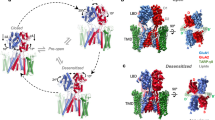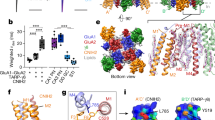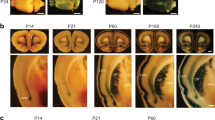Abstract
Although the properties and trafficking of AMPA-type glutamate receptors (AMPARs) depend critically on associated transmembrane AMPAR regulatory proteins (TARPs) such as stargazin (γ-2), no TARP has been described that can specifically regulate the important class of calcium-permeable (CP-) AMPARs. We examined the stargazin-related protein γ-5, which is highly expressed in Bergmann glia, a cell type possessing only CP-AMPARs. γ-5 was previously thought not to be a TARP, and it has been widely used as a negative control. Here we find that, contrary to expectation, γ-5 acts as a TARP and serves this role in Bergmann glia. Whereas γ-5 interacts with all AMPAR subunits, and modifies their behavior to varying extents, its main effect is to regulate the function of AMPAR subunit combinations that lack short-form subunits, which constitute predominantly CP-AMPARs. Our results suggest an important role for γ-5 in regulating the functional contribution of CP-AMPARs.
This is a preview of subscription content, access via your institution
Access options
Subscribe to this journal
Receive 12 print issues and online access
$209.00 per year
only $17.42 per issue
Buy this article
- Purchase on Springer Link
- Instant access to full article PDF
Prices may be subject to local taxes which are calculated during checkout








Similar content being viewed by others
Change history
16 March 2009
In the version of this article initially published, the bar graphs in Figure 7c and 7d were misaligned. The error has been corrected in the HTML and PDF versions of the article.
References
Geiger, J.R. et al. Relative abundance of subunit mRNAs determines gating and Ca2+ permeability of AMPA receptors in principal neurons and interneurons in rat CNS. Neuron 15, 193–204 (1995).
Seeburg, P.H. & Hartner, J. Regulation of ion channel/neurotransmitter receptor function by RNA editing. Curr. Opin. Neurobiol. 13, 279–283 (2003).
Swanson, G.T., Kamboj, S.K. & Cull-Candy, S.G. Single-channel properties of recombinant AMPA receptors depend on RNA editing, splice variation, and subunit composition. J. Neurosci. 17, 58–69 (1997).
Bowie, D. & Mayer, M.L. Inward rectification of both AMPA and kainate subtype glutamate receptors generated by polyamine-mediated ion channel block. Neuron 15, 453–462 (1995).
Kamboj, S.K., Swanson, G.T. & Cull-Candy, S.G. Intracellular spermine confers rectification on rat calcium-permeable AMPA and kainate receptors. J. Physiol. (Lond.) 486, 297–303 (1995).
Koh, D.S., Burnashev, N. & Jonas, P. Block of native Ca(2+)-permeable AMPA receptors in rat brain by intracellular polyamines generates double rectification. J. Physiol. (Lond.) 486, 305–312 (1995).
Bowie, D., Lange, G.D. & Mayer, M.L. Activity-dependent modulation of glutamate receptors by polyamines. J. Neurosci. 18, 8175–8185 (1998).
Rozov, A. & Burnashev, N. Polyamine-dependent facilitation of postsynaptic AMPA receptors counteracts paired-pulse depression. Nature 401, 594–598 (1999).
Cull-Candy, S., Kelly, L. & Farrant, M. Regulation of Ca2+-permeable AMPA receptors: synaptic plasticity and beyond. Curr. Opin. Neurobiol. 16, 288–297 (2006).
Iino, M. et al. Glia-synapse interaction through Ca2+-permeable AMPA receptors in Bergmann glia. Science 292, 926–929 (2001).
Ge, W.P. et al. Long-term potentiation of neuron-glia synapses mediated by Ca2+-permeable AMPA receptors. Science 312, 1533–1537 (2006).
Matsui, K. & Jahr, C.E. Exocytosis unbound. Curr. Opin. Neurobiol. 16, 305–311 (2006).
Gallo, V. Surprising synapses deep in the brain. Nat. Neurosci. 10, 267–269 (2007).
Bellone, C. & Luscher, C. Cocaine triggered AMPA receptor redistribution is reversed in vivo by mGluR-dependent long-term depression. Nat. Neurosci. 9, 636–641 (2006).
Kwak, S. & Weiss, J.H. Calcium-permeable AMPA channels in neurodegenerative disease and ischemia. Curr. Opin. Neurobiol. 16, 281–287 (2006).
Kristensen, A.S. & Traynelis, S.F. Neuroscience: an intrusive chaperone. Nature 435, 1042–1043 (2005).
Nicoll, R.A., Tomita, S. & Bredt, D.S. Auxiliary subunits assist AMPA-type glutamate receptors. Science 311, 1253–1256 (2006).
Osten, P. & Stern-Bach, Y. Learning from stargazin: the mouse, the phenotype and the unexpected. Curr. Opin. Neurobiol. 16, 275–280 (2006).
Priel, A. et al. Stargazin reduces desensitization and slows deactivation of the AMPA-type glutamate receptors. J. Neurosci. 25, 2682–2686 (2005).
Tomita, S. et al. Stargazin modulates AMPA receptor gating and trafficking by distinct domains. Nature 435, 1052–1058 (2005).
Turetsky, D., Garringer, E. & Patneau, D.K. Stargazin modulates native AMPA receptor functional properties by two distinct mechanisms. J. Neurosci. 25, 7438–7448 (2005).
Kato, A.S. et al. New transmembrane AMPA receptor regulatory protein isoform, gamma-7, differentially regulates AMPA receptors. J. Neurosci. 27, 4969–4977 (2007).
Ziff, E.B. TARPs and the AMPA receptor trafficking paradox. Neuron 53, 627–633 (2007).
Soto, D., Coombs, I.D., Kelly, L., Farrant, M. & Cull-Candy, S.G. Stargazin attenuates intracellular polyamine block of calcium-permeable AMPA receptors. Nat. Neurosci. 10, 1260–1267 (2007).
Tomita, S., Fukata, M., Nicoll, R.A. & Bredt, D.S. Dynamic interaction of stargazin-like TARPs with cycling AMPA receptors at synapses. Science 303, 1508–1511 (2004).
Bats, C., Groc, L. & Choquet, D. The interaction between stargazin and PSD-95 regulates AMPA receptor surface trafficking. Neuron 53, 719–734 (2007).
Matsuda, S. et al. Accumulation of AMPA receptors in autophagosomes in neuronal axons lacking adaptor protein AP-4. Neuron 57, 730–745 (2008).
Fukaya, M., Yamazaki, M., Sakimura, K. & Watanabe, M. Spatial diversity in gene expression for VDCCγ subunit family in developing and adult mouse brains. Neurosci. Res. 53, 376–383 (2005).
Burnashev, N. et al. Calcium-permeable AMPA-kainate receptors in fusiform cerebellar glial cells. Science 256, 1566–1570 (1992).
Matsui, K., Jahr, C.E. & Rubio, M.E. High-concentration rapid transients of glutamate mediate neural-glial communication via ectopic release. J. Neurosci. 25, 7538–7547 (2005).
Cho, C.-H., St-Gelais, F., Zhang, W., Tomita, S. & Howe, J.R. Two families of TARP isoforms that have distinct effects on the kinetic properties of AMPA receptors and synaptic currents. Neuron 55, 890–904 (2007).
Korber, C., Werner, M., Kott, S., Ma, Z.L. & Hollmann, M. The transmembrane AMPA receptor regulatory protein gamma 4 is a more effective modulator of AMPA receptor function than stargazin (gamma 2). J. Neurosci. 27, 8442–8447 (2007).
Milstein, A.D., Zhou, W., Karimzadegan, S., Bredt, D.S. & Nicoll, R.A. TARP subtypes differentially and dose-dependently control synaptic AMPA receptor gating. Neuron 55, 905–918 (2007).
Derkach, V., Barria, A. & Soderling, T.R. Ca2+/calmodulin-kinase II enhances channel conductance of α-amino-3-hydroxy-5-methyl-4-isoxazolepropionate type glutamate receptors. Proc. Natl. Acad. Sci. USA 96, 3269–3274 (1999).
Wisden, W. & Seeburg, P.H. Mammalian ionotropic glutamate receptors. Curr. Opin. Neurobiol. 3, 291–298 (1993).
Bergles, D.E., Dzubay, J.A. & Jahr, C.E. Glutamate transporter currents in Bergmann glial cells follow the time course of extrasynaptic glutamate. Proc. Natl. Acad. Sci. USA 94, 14821–14825 (1997).
Clark, B.A. & Barbour, B. Currents evoked in Bergmann glial cells by parallel fibre stimulation in rat cerebellar slices. J. Physiol. (Lond.) 502, 335–350 (1997).
Matsui, K. & Jahr, C.E. Ectopic release of synaptic vesicles. Neuron 40, 1173–1183 (2003).
Douyard, J., Shen, L., Huganir, R.L. & Rubio, M.E. Differential neuronal and glial expression of GluR1 AMPA receptor subunit and the scaffolding proteins SAP97 and 4.1N during rat cerebellar development. J. Comp. Neurol. 502, 141–156 (2007).
Kolleker, A. et al. Glutamatergic plasticity by synaptic delivery of GluR-B(long)-containing AMPA receptors. Neuron 40, 1199–1212 (2003).
Kohler, M., Kornau, H.C. & Seeburg, P.H. The organization of the gene for the functionally dominant alpha-amino-3-hydroxy-5-methylisoxazole-4-propionic acid receptor subunit GluR-B. J. Biol. Chem. 269, 17367–17370 (1994).
Swanson, G.T., Feldmeyer, D., Kaneda, M. & Cull-Candy, S.G. Effect of RNA editing and subunit co-assembly single-channel properties of recombinant kainate receptors. J. Physiol. (Lond.) 492, 129–142 (1996).
Yamazaki, M. et al. A novel action of stargazin as an enhancer of AMPA receptor activity. Neurosci. Res. 50, 369–374 (2004).
Choi, J. et al. Phosphorylation of stargazin by protein kinase A regulates its interaction with PSD-95. J. Biol. Chem. 277, 12359–12363 (2002).
Tomita, S., Stein, V., Stocker, T.J., Nicoll, R.A. & Bredt, D.S. Bidirectional synaptic plasticity regulated by phosphorylation of stargazin-like TARPs. Neuron 45, 269–277 (2005).
Lee, S.H., Simonetta, A. & Sheng, M. Subunit rules governing the sorting of internalized AMPA receptors in hippocampal neurons. Neuron 43, 221–236 (2004).
Piet, R. & Jahr, C.E. Glutamatergic and purinergic receptor-mediated calcium transients in Bergmann glial cells. J. Neurosci. 27, 4027–4035 (2007).
Ziskin, J.L., Nishiyama, A., Rubio, M., Fukaya, M. & Bergles, D.E. Vesicular release of glutamate from unmyelinated axons in white matter. Nat. Neurosci. 10, 321–330 (2007).
Chen, L. et al. Stargazin regulates synaptic targeting of AMPA receptors by two distinct mechanisms. Nature 408, 936–943 (2000).
Kato, A.S., Siuda, E.R., Nisenbaum, E.S. & Bredt, D.S. AMPA receptor subunit-specific regulation by a distinct family of type II TARPs. Neuron 59, 986–996 (2008).
Acknowledgements
We thank C. Bats and D. Studniarczyk for discussion. AMPAR subunit cDNAs were gifts from S. Heinemann (Salk) and P. Seeburg (Heidelberg). TARP cDNAs (rat; γ-2, γ-3, γ-4, γ-5 and γ-8) were gifts from R. Nicoll (University of California San Francisco). This work was supported by a Wellcome Trust Programme Grant (S.G.C.-C. and M.F.), an MRC Molecular Biology Programme studentship (M.Z.) and a Royal Society-Wolfson Research Award (S.G.C.-C.).
Author information
Authors and Affiliations
Corresponding authors
Supplementary information
Supplementary Text and Figures
Supplementary Figures 1–4, Supplementary Tables 1–3 and Supplementary Methods (PDF 3599 kb)
Rights and permissions
About this article
Cite this article
Soto, D., Coombs, I., Renzi, M. et al. Selective regulation of long-form calcium-permeable AMPA receptors by an atypical TARP, γ-5. Nat Neurosci 12, 277–285 (2009). https://doi.org/10.1038/nn.2266
Received:
Accepted:
Published:
Issue Date:
DOI: https://doi.org/10.1038/nn.2266
This article is cited by
-
Stargazin and γ4 slow the channel opening and closing rates of GluA4 AMPA receptors
Scientific Reports (2019)
-
Homomeric GluA2(R) AMPA receptors can conduct when desensitized
Nature Communications (2019)
-
The AMPA Receptor Subunit GluA1 is Required for CA1 Hippocampal Long-Term Potentiation but is not Essential for Synaptic Transmission
Neurochemical Research (2019)
-
Synaptic AMPA receptor composition in development, plasticity and disease
Nature Reviews Neuroscience (2016)
-
Rediscovering area CA2: unique properties and functions
Nature Reviews Neuroscience (2016)



